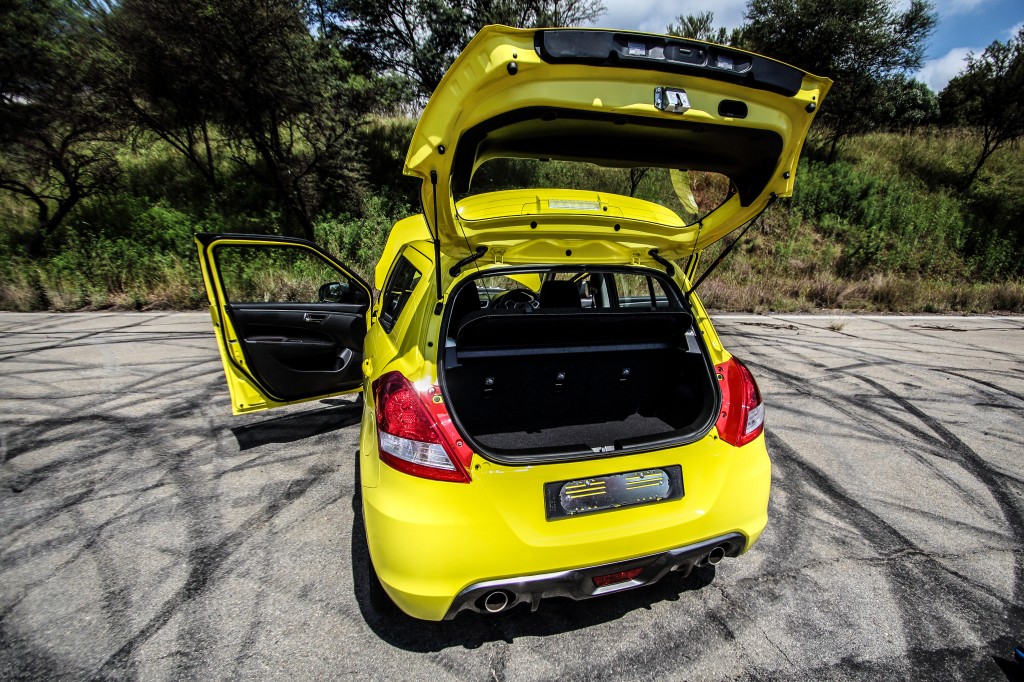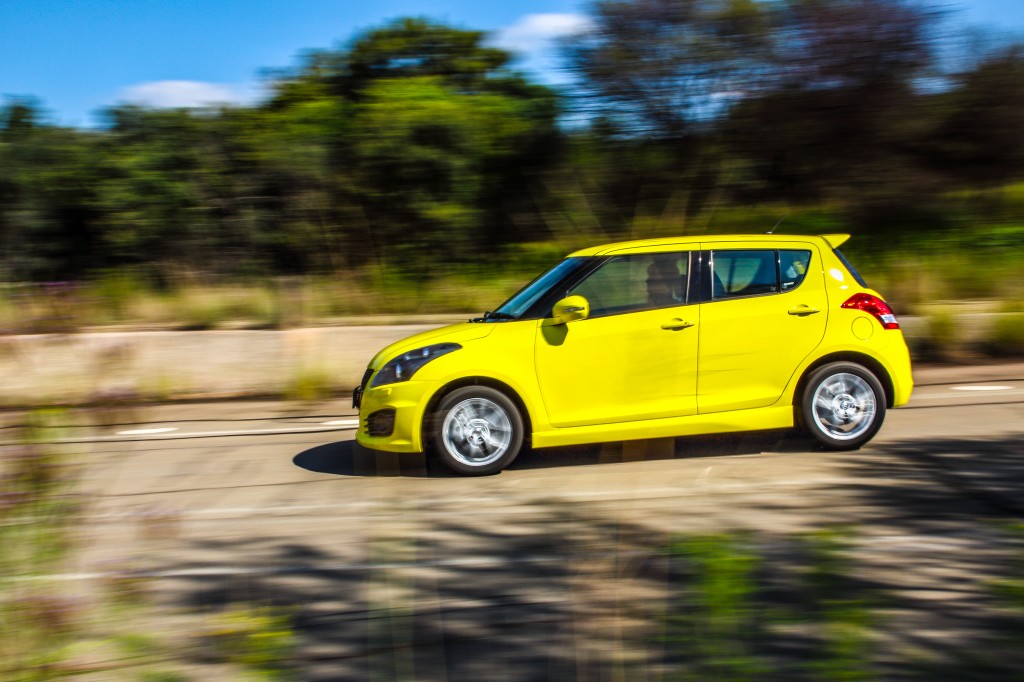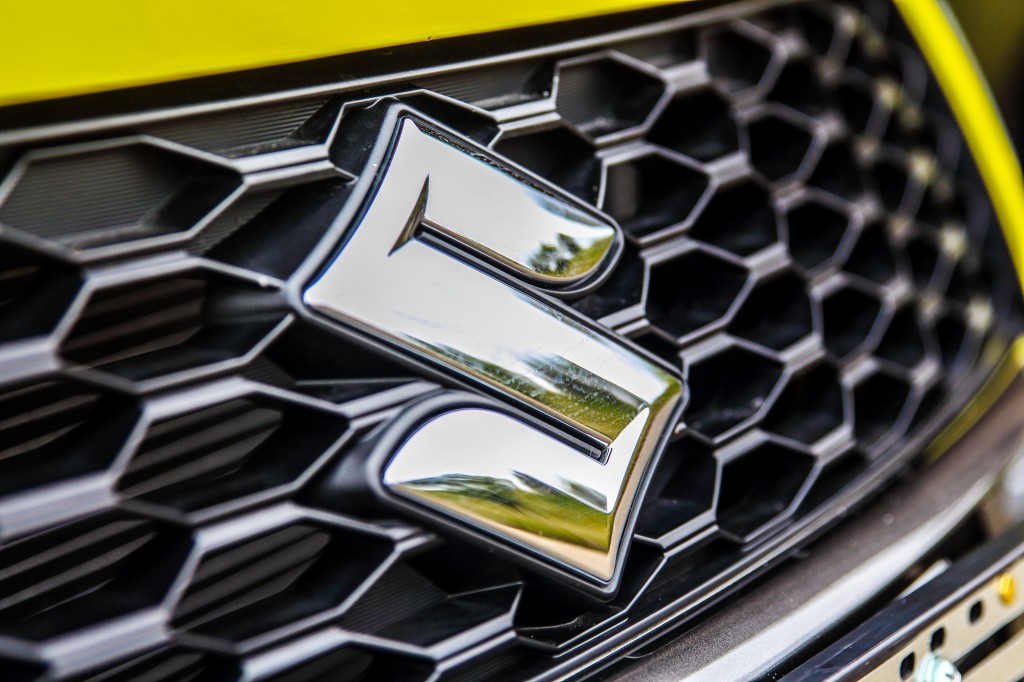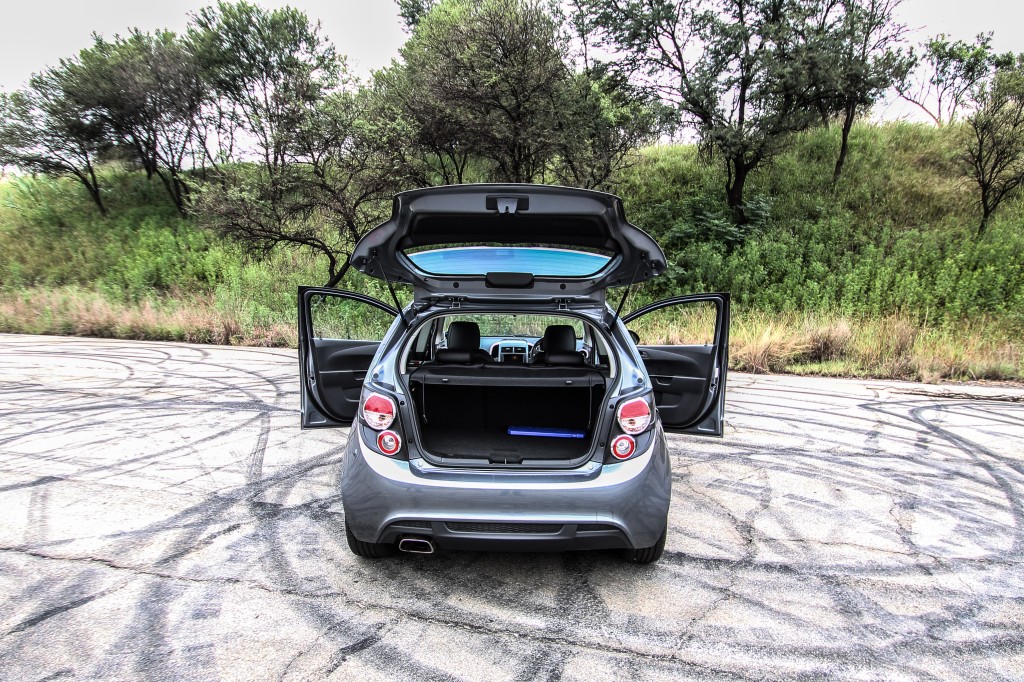In the affordable warm-hatch segment, the Suzuki Swift Sport has stood in solitude since it first arrived on the scene in 2012. Now, Chevrolet has brought about the first real rival to the Swift Sport in the guise of the Chevrolet Sonic RS. We sought to see which would claim the warm hatch title in an epic battle of natural aspiration versus forced induction.
Visually, little separated the two in size, nearly millimetre accurate to one another in length, width and height. The Suzuki was all round the sportier looking package, with dual exhaust pipes and aggressive bodywork, whilst the Sonic, from any angle except the front and front ¾, looked downplayed and sedate, only besting the Swift outright with its 17-inch midnight silver aluminium wheels.
Internally, both vehicles were evenly matched on material quality and design. The Suzuki had better ergonomics, and felt more comfortable to sit in, thanks in large part to the wonderfully supportive sport seats, whereas the Chevrolet was a little awkward, as if built for those with short legs and long arms. The leather and microfiber seats in the Sonic, embossed with RS logos, felt classy, but lacked enough bolstering and support to be deemed better than the Swift’s cloth-clad seats. The Sonic did, however, have the better of the Swift in the infotainment stakes, where despite the addition of Bluetooth for the 2014 year, the Swift’s media system was outdated and outclassed by the intuitive, responsive MyLink touch screen system in the Chevrolet. The Chevrolet also bested the Suzuki in flexibility, with easier access to the rear seats, and a far larger boot space than that of the Swift.
Providing affordable fun to the young petrolhead without endangering lives or wallets has always been the greatest measure of the perfect warm hatch, and out on the roads between Jo’burg and Hartbeespoort, this would be the real test between the two feisty hatches at hand.
Out on the open road, there was little to separate the two – both had charm in their own right. The Suzuki’s lovely engine growl and wind-up ability made it a pleasure to drive up to its 7000 rpm redline, but the Chevrolet’s turbo-torque advantage of 40Nm was noticeable in any gear. Both were highly compliant on good road surfaces too, however after the recent rain and the usual Gauteng road conditions, the two grew further apart in likeness.
Despite the turbo-torque on offer, the short gearing of the Sonic offered little that the normally aspirated Swift Sport didn’t. The joyful ability to wring the Suzuki out ‘til redline was only matched by its superb throttle mapping and wonderful pedal placement, making heel ‘n’ toe shifting second nature in its ease. The gearbox had a natural solidity to it, sucking the shifter into place as the 6-speed manual worked its way through the cogs. The Sonic lacked the solidity of the Swift in shifting; however the short gearing meant power was readily available in any gear – a pleasure particularly heading uphill, where the Suzuki required a fair amount of shift-work.
As the roads grew rougher and twistier, both the Sonic and the Swift were forced to show their talent in full. The Sonic, although pliant and comfortable on ideal roads somewhat lacked composure on rougher terrain. The suspension became rougher, and the dampers weren’t able to keep up with the rapidly changing road surface – the hard rear suspension often resulting in the RS breaking traction and hopping across the road surface. The front tyres remained glued though – with 205/50 R17 ContiPremium rubber it was to be expected – but the steering was somewhat indirect, and slightly heavy to the touch. Steering wheel play just off centre resulted in an inability to make minor adjustments on the fly, and the feedback through the wheel, although present, wasn’t fully communicative. In such a small vehicle, a greater sense of urgency in steering response would have been appreciated, but the RS was nonetheless responsive and fairly direct in its action and ability to move about the road.
The Swift Sport proved to be a somewhat different beast on the twisting roads near Hartbeespoort. The suspension, which was firm at slower speeds and seemed rougher on well-surfaced roads, reacted better the harder it was pushed – the dampers responding to every inflection in the road surface with instantaneous response. Around harder bends, the Swift remained flat, sucking itself to the road surface and yielding little to the physics that, in the Sonic, made the ride wallowy and soft by comparison. The Swift reacted in a most terrier-like manner, a Jack Russell darting after a tennis ball with urgency and intent, responding telepathically to steering inputs – the rear wheels not following the front ones, but moving with them, the Swift as a single unit darting about the road surface.
The Suzuki’s prowess didn’t end there though – it inspired confidence at every moment of the journey. Where the Sonic RS felt unsure of itself on poorer road conditions at higher speeds, the unflappable confidence of the Swift seemed never-ending. Despite riding on narrower 195/50 R16 Yokohama Advan tyres, it managed to grip and grip and grip some more, defying physics with an almost magical tenacity. The Sonic was limited by its own soft suspension and awkward road placement, whereas the Swift had only one limitation – how far the driver was willing to go – and even then, when reaching its limits, the Suzuki would gently tap on my shoulder as if to say, “It’s OK, I’ve got this.”
Both vehicles, when at their limit, would let go of the surface beneath them, but where the Sonic seemed rushed and upset, the Suzuki seemed unfazed; able to enter 2- and 4-wheels drifts in complete control, without any hesitance or urgency whatsoever. Where the road only allowed a metre to play with, the Swift granted what seemed to be a mile of space to play in, changing direction and adapting to the surface with the slightest of inputs from the throttle and steering wheel. The Swift seemed to place itself perfectly on the road; intuitively reading the road surface and the driver inputs to find the perfect line through every corner and flowing bend.
The Sonic RS was more than adept at carving up twisty pieces of tarmac, and it was controllable at its limits; but where the Swift Sport was a scalpel, sharp and incisive, the Sonic was a knife with a pillow over the tip, not blunt, but soft by comparison to the Suzuki.
However the Sonic RS stood to regain some of its credibility; all was not lost as the turbocharged 1.4-litre engine offered an additional 3kW and 40Nm over the Swift Sport’s normally aspirated 1.6-litre mill. At Gauteng altitude, the Sonic loses very little of its punch, whereas the Swift, scientifically, would lose anything from 16- to 20% of its pulling power.
A good old fashioned drag race would do the test just fine, so both cars lined up on the tarmac, ready to launch. Off the line, little separated the two warm-hatches. From 0-60km/h, the Sonic had the better of the Suzuki, the short gearing playing to its advantage, placing it within the power band consistently for optimal acceleration. 1st-2nd gearshift was a problem in the Sonic though, as snap-shifts resulted in a grind between the first two gears. 2nd and 3rd gears provided optimum acceleration for the Sonic RS, giving it half a car’s-length advantage over the Swift Sport.
However after 60km/h, the gap stabilised, and the Suzuki’s wind-up nature allowed it to stretch its legs as the speed grew. Under perfect launch conditions, the Sonic RS would have the better of the Swift 10 out of 10 times, but the difference was almost negligible to the point that a poor launch on the part of Chev would result in a dead heat, or even a loss for the turbocharged competitor.
Rolling starts yielded a similar result, minus the launch issues, with the Sonic pulling away in 2nd and 3rd gear consistently before the gap stabilised at a single car’s length, the Swift somehow negating the forced induction difference from mid-way through 3rd gear and upwards.
At the end of the day, the Sonic had the Swift beaten on standing and rolling acceleration, barely; but the Swift’s ability to almost entirely negate 40Nm and 3kW was uncanny. The Sonic was also unable to confidently trump the Swift in fuel consumption figures, with the Suzuki being largely more economical under duress, and only slightly less economical under regular driving – the Suzuki sipping 6.3l/100km, whilst the effortless torque of the Chevrolet helped it to figures of 6.2l/100km.
The dynamic ability of the Swift Sport was more than enough to offset any noticeable power difference; and the Sport’s ability to respond better the harder it was pushed greatly outweighed the RS’ comfort and usability on perfectly laid roads. The Chevrolet Sonic RS is a fantastic car – offering comfort and a playful nature with the ability to go fast with relative ease, as well as have fun at all times. It deserves to sell in great numbers as it offers a highly complete package, perfectly rounded off by a superb media setup in the MyLink system.
Against any other competitor the Sonic RS would likely have proved to be the victor, however the Suzuki Swift Sport is not “any other competitor”. The Suzuki has been engineered as one single-minded, complete machine, responding with zeal the harder it gets pushed, fusing car and driver into one of the most complete machines I’ve driven in my time as a journalist. The Suzuki Swift Sport chews on the laws of physics and spits them out before asking for something tougher – it has been hard-wired with tenacity and what can only be described as magic.
Standing in solitude, the Sonic RS is a brilliant fun-hatch, but alongside the sheer magnificence of the Swift Sport, it just couldn’t quite measure up. It has been said that straight roads are just the boring bits that connect the fun bits together, but when driving a Swift Sport, every piece of road is an occasion.
|
SCORECARD: |
||
| Suzuki Swift Sport | Chevrolet Sonic RS | |
| Appearance | 9/10 | 8/10 |
| Space & Usability | 6/10 | 8/10 |
| Infotainment | 6/10 | 9/10 |
| Comfort | 8/10 | 9/10 |
| Acceleration | 8.5/10 | 9/10 |
| Braking | 9/10 | 8/10 |
| Suspension | 9/10 | 7.5/10 |
| Steering | 10/10 | 7.5/10 |
| Handling | 10/10 | 7/10 |
| Fun Factor | 10/10 | 8/10 |
| TOTAL: | 85.5/100 | 81/100 |
Winner: Suzuki Swift Sport – Whilst the scorecard places the 2 vehicles very close, the Suzuki offered a superior driving experience, losing out on points due to the small boot, difficult to access rear seats, and inferior entertainment system.
|
The Figures: |
||
|
Chevrolet Sonic RS: |
Suzuki Swift Sport: |
|
| Engine Capacity: |
1364cc |
1586cc |
| No. of Cylinders: |
4 |
4 |
| Max. Power: |
103kW @ 6000RPM |
100kW @ 6900RPM |
| Max. Torque: |
200Nm @ 4000RPM |
160Nm @ 4400RPM |
| Gearbox: |
6-speed Manual |
6-speed Manual |
| 0-100 time (Claimed): |
9.5 seconds |
8.7 seconds |
| Top Speed: |
197km/h |
195km/h |
| Dry Weight: |
1275Kg |
1060Kg |
| Fuel Tank Capacity: |
46 litres |
42 litres |
| Fuel Consumption: |
6.2l/100km |
6.3l/100km |
| Drivetrain |
FrontWheel Drive(FF) |
FrontWheel Drive(FF) |
| Price (as tested): |
R225 300 |
R223 900 |
~~~
Author: Roger Biermann
Photography: Jeremy Phillips & Yolande Strydom
Drivers: Martin Pretorius & Roger Biermann




















































